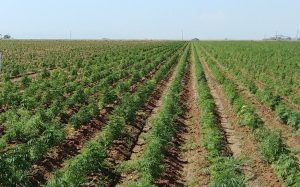
Hemp farmers need to check the market and stop using below-average fields for the new commodity, according to a longtime producer who kicked off a collaboration between the federal government and Cornell University to advance the young industry.
Jeffrey Kostuik, general manager and head of sales for Hemp Genetics International in Russell, Manitoba, said that whether farmers are growing hemp for cannabinoid extraction, fiber or grain, they need to first identify what the market demands and how they can profitably and responsibly supply high-quality hemp.
Farmers should also avoid using suboptimal land to try a new crop while expecting profitable results.
Agronomically, hemp can be confusing, Kostuik said, but breaking down the elements of production helps simplify outdoor cultivation.
Field selection
To get started, farmers can the ensure the best possible outcomes and yields by selecting the best land they have and paying careful attention to the planting conditions and soil properties, according to Kostuik.
In the early days of hemp production in Canada, farmers would choose fields in “the back 40” or wherever they wouldn’t flag attention from other producers. But that wasn’t the best strategy considering hemp’s sometimes picky nature, he said.
When choosing a field or plot, growers should consider criteria such as the field’s crop rotation history, including the past use of herbicides.
“Hemp is quite susceptible to most herbicides, and a lot of the residual herbicides can cause a problem with establishment – and establishment is one of the toughest things to get your head wrapped around with hemp,” Kostuik advised.
In terms of soil fertility, many in the hemp industry believe that hemp can grow without adding nutrients, but it’s a tall and aggressive plant, which means it needs them.
“It’s not a nitrogen fixer; it’s a high user of nitrogen, high user of potassium,” he said. “So we have to make sure that we can feed the crop accordingly.”
Growers should look at problem weeds in the field as well.
Hemp relies on its its plant structure to shade out weeds and rob them of their nutrients. But if there are well-established problem weeds, hemp can have a difficult time getting through, Kostuik said.
Soil properties
Ideally for hemp production, field soil will have moderate soil texture with loamy, clay loam or sandy loam properties. Heavy clay should be avoided mainly due to moisture, Kostuik said.
“It’s not to say that hemp couldn’t do well on heavy clays, but it really just does not like its feet wet,” he said.
“If soil is compacted or there are any irregularities in your field … hemp will be the one crop that will show you where your problems are.”
Sandy soils don’t have the issue of standing water, and they will work well for production with adequate moisture, as hemp needs upwards of 12 to 15 inches of moisture to reach its genetic yield potential, Kostuik said.
“Non-saline, good tilth – in other words, some of your best land you want to be planting hemp on.”
More to come
Kostuik’s advice is part of a collaboration between the U.S. Department of Agriculture’s Agricultural Research Service and Cornell University to provide information on hemp research to producers and plant scientists.
A free webinar series from the collaboration features several detailed presentations by hemp researchers from academia, research laboratories, production facilities and private industry, including:
- Feb. 9 – Indoor Cultivation: Bruce Bugbee
- Feb. 23 – Hemp Processing Systems: Heather Grab
- March 9 – Extraction Chemistry/Facility Design: Alisia Ratliff
- March 23 – The Endocannabinoid System: Dr. Ethan Russo
- April 6 – Hemp Food Science: Hunter Friedland
- April 20 – Hemp Diversity/Genetics: Daniela Vergara
- May 4 – Economics of Hemp Production: Tyler Mark
Learn more about the elements of outdoor hemp production, including variety selection, seeding, fertility, weed control and harvest, from Kostuik’s archived webinar on the Cornell YouTube channel.
Laura Drotleff can be reached at [email protected]

